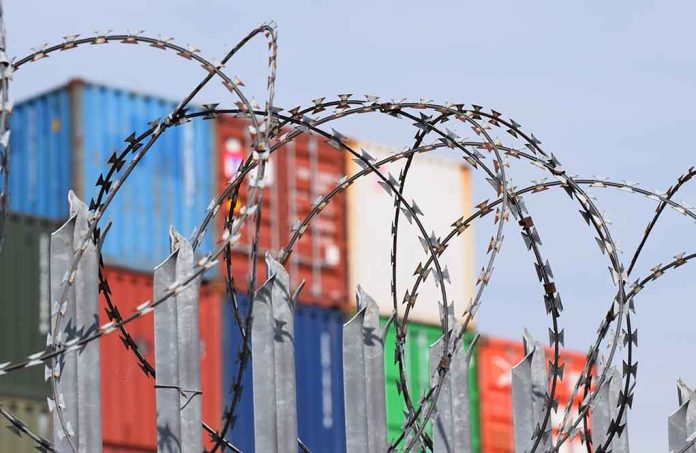
Trump administration may revise Chinese vessel port fees after shipping industry pushback threatens supply chain stability and raises concerns about economic impacts on smaller American ports.
Key Takeaways
- The Trump administration is reconsidering its proposed fee system on China-linked ships after significant opposition from shipping groups and businesses.
- Proposed fees of up to $3 million per port call for Chinese-built or operated vessels aimed to boost domestic shipbuilding but raised concerns about supply chain disruptions.
- Smaller ports like Boston’s Conley Terminal fear being bypassed as ships may reroute to larger facilities to avoid fees, threatening local jobs and businesses.
- American-owned carriers serving domestic routes argue they would be disproportionately harmed by the fees compared to international competitors.
- Alternative approaches being considered include delayed implementation, variable fee systems based on ship size, and potential exemptions for U.S. companies.
Proposed Chinese Vessel Fees Face Strong Industry Opposition
The Trump administration is reviewing its controversial plan to impose steep port fees on China-linked ships after encountering substantial resistance from shipping industry stakeholders. The initial proposal, part of the “Restoring America’s Maritime Dominance” initiative, would impose fees of $1 million for Chinese-operated ships, $1.5 million for ships built in China, and $1 million for shipping lines with over 50% of new vessels built in China – potentially totaling up to $3 million per port call.
Trade Representative Jamieson Greer has acknowledged the administration is carefully weighing industry feedback while confirming some version of the fees will move forward. A primary concern driving the policy is the significant decline in American shipbuilding capacity compared to China’s dominance in the sector, which the administration views as a national security vulnerability requiring correction.
Smaller Ports Expect Significant Impact
Leaders of smaller port facilities, like Rich Davey of the Massachusetts Port Authority, have expressed serious concerns about the proposed fee structure. Conley Terminal in Boston, which processes approximately 2.3 million metric tons of cargo annually, could face severe business disruption if the fees are implemented as originally planned. Port authorities fear ships would simply bypass smaller facilities in favor of larger ports like New York to minimize fee exposure.
“We would likely see a number of ships deciding to skip us and probably go right to New York,” Davey said.
The American Association of Port Authorities, representing 81 ports across the country, has warned that the fee structure could create market distortions and logistical complications reminiscent of supply chain disruptions experienced during the COVID-19 pandemic. Particular concern centers on American exporters, whose products could become less competitive in international markets as shipping costs rise.
Domestic Carriers Seek Exemptions
U.S. shipping companies have emerged as some of the most vocal critics of the proposed fee structure, arguing that American-owned carriers would bear a disproportionate burden compared to international competitors. These companies are actively lobbying for exemptions for U.S. firms that use Chinese-built vessels, highlighting that the limited state of domestic shipbuilding makes immediate alternatives virtually nonexistent.
“We want to boost shipbuilding at home without hurting our own economy,” said US trade representative Jamieson Greer.
The administration is exploring several modifications to the original plan, including a phased implementation approach, variable fee structures based on vessel size or fleet composition, and targeted exemptions. These adjustments aim to balance the strategic goal of revitalizing American shipbuilding with practical concerns about immediate economic impacts and supply chain stability.
Broader Maritime Strategy Remains in Focus
Despite the controversy surrounding the port fees, other elements of the “Restoring America’s Maritime Dominance” package continue to advance. These include initiatives to develop a comprehensive national shipbuilding plan, prevent circumvention of Harbor Maintenance Fees, and create Maritime Prosperity Zones designed to stimulate investment in port infrastructure and related industries.
“Imagine attaching a million-dollar fee to a vessel full of wood pulp,” said Ian Gansler of the American Association of Port Authorities. “You’re going to find it cheaper somewhere else.”
The port fee reconsideration comes amid broader escalation in U.S.-China trade tensions, with the U.S. planning new tariffs on Chinese imports and China announcing a 34% tariff on American goods. Administration officials maintain that addressing the imbalance in maritime capabilities remains a critical priority for national security and economic sovereignty reasons, even as specific implementation details continue to evolve.
Sources:
- https://timesofindia.indiatimes.com/world/us/trump-may-delay-or-revise-proposed-fees-on-chinese-built-ships-entering-us-ports-report/articleshow/120109846.cms
- https://www.wbur.org/news/2025/04/09/massport-fees-china
- https://www.reuters.com/world/us/us-considers-adjusting-port-fee-plan-chinese-vessels-after-pushback-sources-say-2025-04-08/










